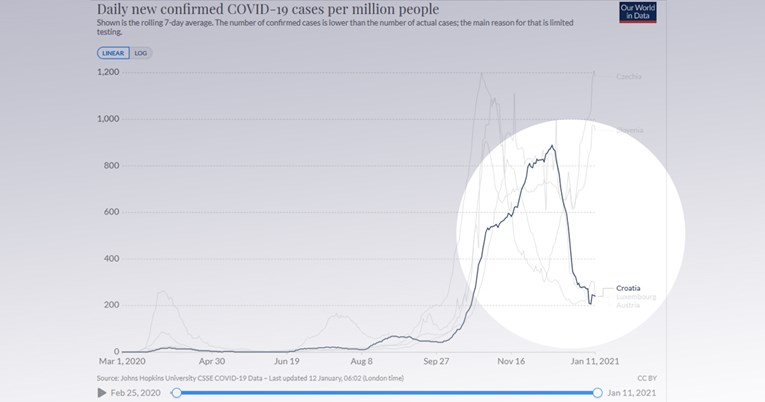Index.hr reports that after introducing strict epidemiological measures, Croatia records the largest decline in the number of new infections in the European Union.
As the Our World in Data page chart shows, with about 900 new infections per million inhabitants on December 13, when it was one of the worst in the EU, by January 11, Croatia had reached about 240 cases.
It is essential that the number of hospitalized and dead is dropping, too. Of the 20 deaths from COVID-19 per million inhabitants per day on December 21, that number dropped by January 11 to about 10.
A similar decline is recorded in neighboring Serbia, but the number of newly infected people is currently not as favorable as in Croatia. It records about 320 new infections per million inhabitants. On the other hand, with 5 deaths per million inhabitants, Serbia is better than Croatia according to that statistic. Therefore, it is not clear whether the smaller number of newly infected in Croatia is partly due to a smaller scope of testing.
The steep decline in Croatia followed the closure of cafes, restaurants, and gyms and the restriction of gatherings on November 28, 2020. It was probably also helped by moving to online classes, which was introduced on December 14, and in many schools even before that.
This is in line with research published in the world-renowned journals Scientific Reports Nature and Science.
Namely, a study published in the journal Science on December 15, conducted in 34 European and seven non-European countries, showed that closing schools and universities, limiting gatherings to 10 people or less, and closing most non-essential businesses where close contacts are made, especially nightclubs, bars, and restaurants, have the greatest impact on combating the epidemic.
Similarly, a study published in the journal Scientific Reports Nature was conducted on a sample of 79 territories, which included countries and different states in the United States. According to the study, which analyzed the effects of a wider range of measures, the most effective were curfew, lockdown, closure or restriction of places where people gather (shops, restaurants, etc.), closure of educational institutions (both schools and universities) and the introduction of border restrictions.
This decline is a reason for optimism, but it should be noted that some countries have fared much better than Croatia. For example, Iceland went through a mild two waves that it brought under control relatively quickly while Finland barely felt a pandemic, both in the first and second waves.
The reason for caution is that there is a new strain of the virus that is spreading significantly faster than usual in several European countries.
To read more about COVID-19 in Croatia, follow TCN’s dedicated page.









